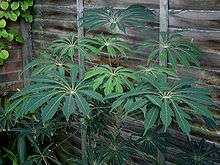Schefflera taiwaniana
Schefflera taiwaniana (台湾鹅掌柴)[2] is a species of flowering plant in the family Araliaceae, native to Taiwan, where it is scattered throughout coniferous forests at 2,000–3,000 m (6,600–9,800 ft).[2] Growing to 4 m (13 ft) tall by 2.5 m (8.2 ft) broad, it is an evergreen shrub or small tree. Large leaves up to 15 cm (5.9 in) long are composed of up to 11 ovate leaflets arranged radially around a central stalk (palmately compound). Young leaves are covered in silver hairs, while mature leaves have a smooth surface. Sprays of flowers in late summer are followed by dark berries in winter - a valued food source for insects and birds.[3]
| Schefflera taiwaniana | |
|---|---|
 | |
| Scientific classification | |
| Kingdom: | Plantae |
| Clade: | Tracheophytes |
| Clade: | Angiosperms |
| Clade: | Eudicots |
| Clade: | Asterids |
| Order: | Apiales |
| Family: | Araliaceae |
| Genus: | Schefflera |
| Species: | S. taiwaniana |
| Binomial name | |
| Schefflera taiwaniana (Nakai) Kaneh. | |
Related to the ivies (Hedera), Schefflera taiwaniana is one of several species in the hugely varied genus Schefflera (umbrella plants) that are grown ornamentally for their handsome foliage.[3] Once mature it is hardy down to −10 °C (14 °F), though young plants may require some frost protection. It benefits from being planted in a sheltered spot with other plants to provide enough humidity. It has gained the Royal Horticultural Society’s Award of Garden Merit.[4][5]
References
- Frodin, D. (1998). "Schefflera taiwaniana". The IUCN Red List of Threatened Species. IUCN. 1998: e.T31256A9620545. doi:10.2305/IUCN.UK.1998.RLTS.T31256A9620545.en. Retrieved 22 December 2017.
- "Schefflera taiwaniana". Flora of China. Retrieved 6 November 2018.
- Blackhall-Miles, Robbie (12 December 2013). "Umbrella group: why not make room for a Schefflera?". The Guardian. Retrieved 6 November 2018.
- "RHS Plantfinder - Schefflera taiwaniana". Retrieved 1 November 2018.
- "AGM Plants - Ornamental" (PDF). Royal Horticultural Society. July 2017. p. 95. Retrieved 1 November 2018.
